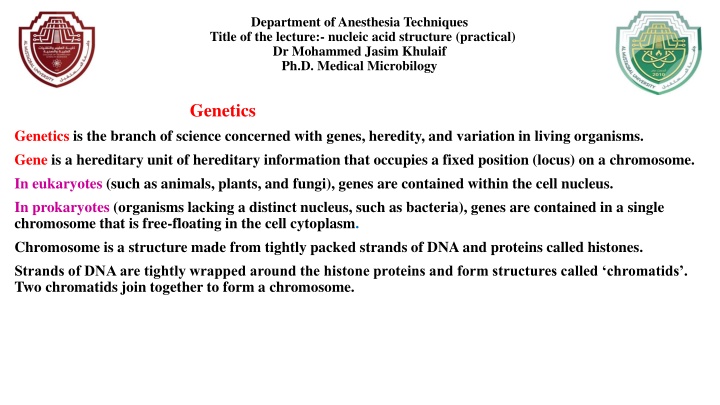
Nucleic Acid Structure Lecture Overview
Explore the fundamentals of genetics, nucleic acids, and DNA structure in this practical lecture by Dr. Mohammed Jasim Khulaif. Understand the role of genes, chromosomes, and complementary base pairing in genetic information. Dive into the world of nucleotides, purines, pyrimidines, and the unique structures of DNA and RNA. Enhance your knowledge of heredity and variations in living organisms through this insightful session.
Download Presentation

Please find below an Image/Link to download the presentation.
The content on the website is provided AS IS for your information and personal use only. It may not be sold, licensed, or shared on other websites without obtaining consent from the author. If you encounter any issues during the download, it is possible that the publisher has removed the file from their server.
You are allowed to download the files provided on this website for personal or commercial use, subject to the condition that they are used lawfully. All files are the property of their respective owners.
The content on the website is provided AS IS for your information and personal use only. It may not be sold, licensed, or shared on other websites without obtaining consent from the author.
E N D
Presentation Transcript
Department of Anesthesia Techniques Title of the lecture:- nucleic acid structure (practical) Dr Mohammed Jasim Khulaif Ph.D. Medical Microbilogy Genetics Genetics is the branch of science concerned with genes, heredity, and variation in living organisms. Gene is a hereditary unit of hereditary information that occupies a fixed position (locus) on a chromosome. In eukaryotes (such as animals, plants, and fungi), genes are contained within the cell nucleus. In prokaryotes (organisms lacking a distinct nucleus, such as bacteria), genes are contained in a single chromosome that is free-floating in the cell cytoplasm. Chromosome is a structure made from tightly packed strands of DNA and proteins called histones. Strands of DNA are tightly wrapped around the histone proteins and form structures called chromatids . Two chromatids join together to form a chromosome.
Department of Anesthesia Techniques Title of the lecture:- nucleic acid structure (practical) Dr Mohammed Jasim Khulaif Ph.D. Medical Microbilogy Nucleic acids are the carriers of genetic information, in all living organisms. Two major classes of nucleic acids:- Deoxyribonucleic acid (DNA): carrier of genetic information Ribonucleic (RNA): an intermediate in the expression of genetic. The monomeric units for nucleic acids are nucleotides. Nucleotides are made up of three structural subunits 1.Sugar: ribose in RNA- deoxyribose in DNA 2.Nitrogenous base 3.Phosphate Note:- Nucleotides = nucleoside + phosphate Nucleosides = Nitrogenous base + sugar Sugar= Ribose (in RNA) , Deoxyribose(in DNA) Nitrogenous base Purine and Pyrimidines
Department of Anesthesia Techniques Title of the lecture:- nucleic acid structure (practical) Dr Mohammed Jasim Khulaif Ph.D. Medical Microbilogy Complementary Base Pairing The nitrogenous bases may form hydrogen bonds according to complementary base pairing: Adenine always forms two hydrogen bonds with thymine / uracil Guanine always forms three hydrogen bonds with cytosine
Department of Anesthesia Techniques Title of the lecture:- nucleic acid structure (practical) Dr Mohammed Jasim Khulaif Ph.D. Medical Microbilogy DNA Deoxyribonucleic acid is a coiled double helix carrying hereditary information of the cell. DNA made of 4 nitrogen-containing bases held together by weak hydrogen bonds Purines (double carbon-nitrogen rings) include adenine (A) and guanine (G) Pyrimidines (single carbon-nitrogen rings) include thymine (T) and cytosine (C) Base pairing means a purine bonds to a pyrimidine (Example: A T and C G) Sides made of pentose (5-sided) sugars attached to phosphate groups by phosphodiester bonds Subunits of DNA called nucleotides
Department of Anesthesia Techniques Title of the lecture:- nucleic acid structure (practical) Dr Mohammed Jasim Khulaif Ph.D. Medical Microbilogy RNA Ribonucleic acid Single stranded molecule Found in nucleus & cytoplasm Contains ribose sugar Contains the nitrogen base uracil (U) instead of thymine Three types of RNA exist (mRNA, tRNA, & rRNA) RNAmolecules are formed from DNA molecules by process Called transcription Messenger RNA (mRNA) Single, uncoiled, straight strand of nucleic acid mRNA is translated to amino acid sequence o to form protein by process called trnslation
Department of Anesthesia Techniques Title of the lecture:- nucleic acid structure (practical) Dr Mohammed Jasim Khulaif Ph.D. Medical Microbilogy t-RNA (Transfer RNA ) Single stranded molecule containing 80 nucleotides in the shape of a cloverleaf Carries amino acids in the cytoplasm to ribosomes for protein assembly . Ribosomal RNA)r-RNA( Globular shape Helps make up the structure of the ribosomes Ribosomes are the site of translation to produce protein















